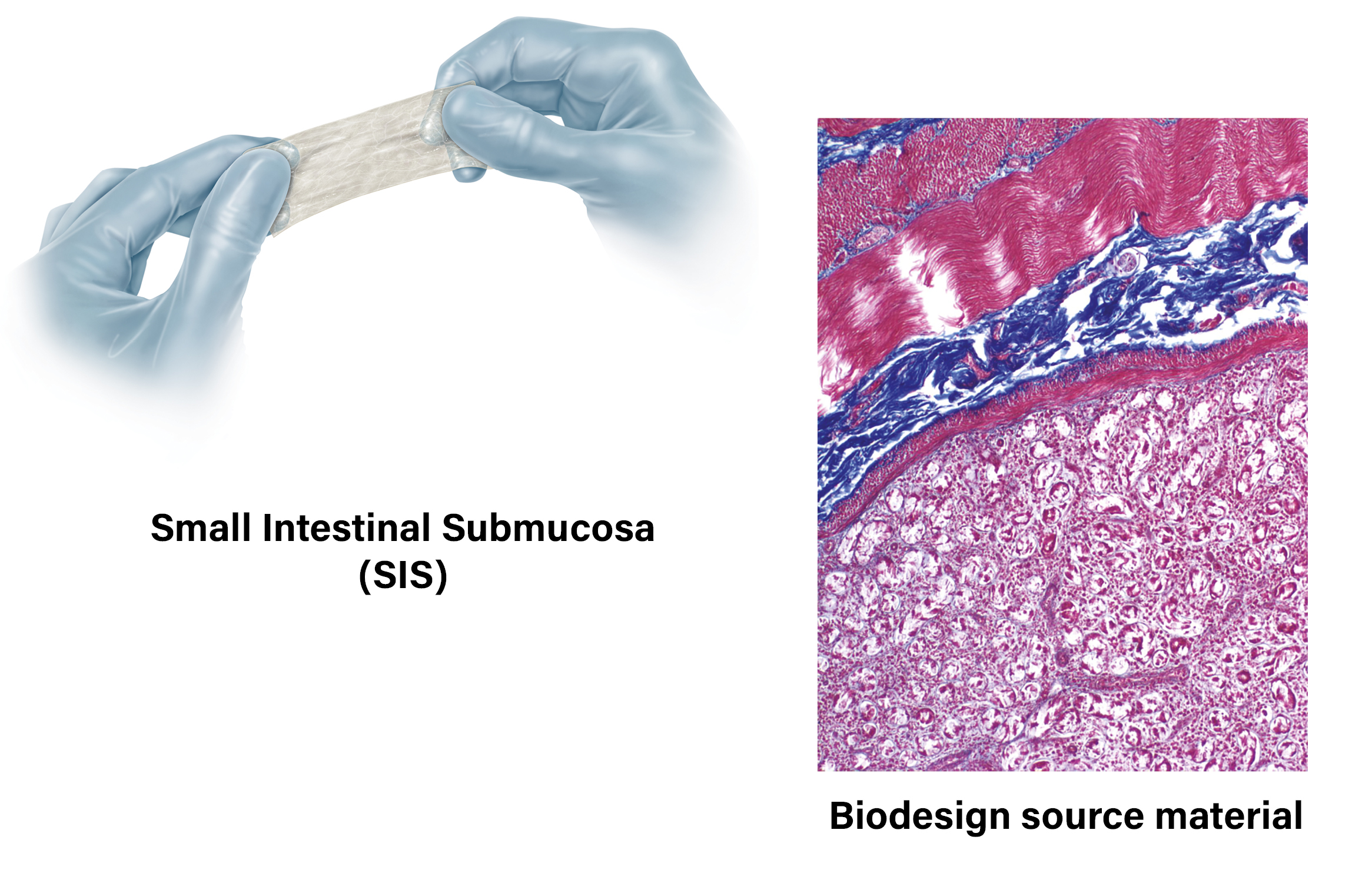The Biodesign Fistula Plug is a tapered small intestinal submucosa (SIS) cylinder with an SIS button. The SIS button is fastened to the wide end of the cylinder with resorbable polyglycolic acid (PGA) suture.
Once implanted the natural composition of SIS allows for the patient’s healing mechanisms to deposit cells and collagen during cellular and extracellular matrix metabolism.
Biodesign Advanced Tissue Repair products are sourced from porcine small intestinal submucosa (SIS).
Over the course of several months, the patient’s own healing mechanisms incorporate the SIS into the adjacent tissues until it can no longer be detected, resulting in new, remodelled tissue.1-3

SIS technology
SIS is derived from porcine small intestinal submucosa, a naturally occurring ECM (extracellular matrix) located between the mucosal and muscular layers of the small intestine. A complex organization of collagen and other molecules that forms a fibrous matrix, the submucosal layer of the intestine is responsible for most of its strength.
SIS provides a natural scaffold that allows the body to restore itself through site-specific tissue remodelling.

Tissue Remodelling
Tissue remodelling is a complex natural process that involves the recruitment of cells,
the renewal of tissue composition, and the reinforcement of structural tissue architecture.4
As the body heals, SIS is gradually remodelled and integrated into the body, leaving behind organized tissue that provides long-term strength.5-7
SHOW REFERENCES
1. Mantovani F, Tondelli E, Cozzi G, et al. Reconstructive urethroplasty using porcine acellular matrix (SIS): evolution of the grafting technique and results of 10-year experience. Urologia. 2011;78(2):92-97.
2. Palminteri E, Berdondini E, Fusco F, De Nunzio C, Salonia A. Long-term results of small intestinal submucosa graft in bulbar urethral reconstruction. Urology. 2012;79(3):695-701.
3. Xu YM, Fu Q, Sa YL, Zhang J, Song LJ, Feng C. Outcome of small intestinal submucosa graft for repair of anterior urethral strictures. Int J Urol. 2013;20(6):622-629.
4. Turner NJ, Badylak SF. Biologic scaffolds for musculotendinous tissue repair. Eur Cell Mater. 2013;25:130-143.
5. Franklin ME Jr, Trevino JM, Portillo G, Vela I, Glass JL, Gonzalez JJ. The use of porcine small intestinal submucosa as a prosthetic material for laparoscopic hernia repair in infected and potentially contaminated field: a long term follow-up. Surg Endosc. 2008;22(9):1941-1946.
6. Stelly M, Stelly TC. Histology of CorMatrix bioscaffold 5 years after pericardial closure. Ann Thorac Surg. 2013;96(5):e127-e129.
7. Badylak S, Kokini K, Tullius B, Whitson B. Strength over time of a resorbable bioscaffold for body wall repair in a dog model. J Surg Res. 2001;99(2):282-287.
The Biodesign Fistula Plug is for implantation to reinforce soft tissue for repair of anorectal fistulas.
The plug is supplied and intended for one time use.
The plug is derived from porcine source and should not be used for patients sensitive to porcine materials.
*See full instructions for use for the Biodesign Fistula Plug here
| Description | Product code | Order code |
|---|---|---|
| Biodesign Fistula Plug Set | C-FPS-0.7-2 | G46373 |
| Biodesign Fistula Plug Set | C-FPS-0.4-2 | G46372 |
| Biodesign Fistula Plug Set | C-FPS-0.2-2 | G46374 |
| Cook Fistula Brush* | J-FB-100 | G48527 |
*Used to identify, clean or debride an anal or rectovaginal fistula tract and facilitate placement of the Biodesign Fistula Plug.
At the heart of healthcare
